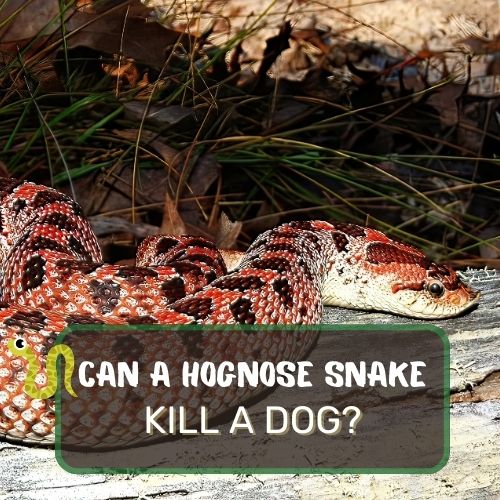
“Can a hognose snake kill a dog?” It’s a question that has crossed the minds of many pet owners and reptile enthusiasts alike.
With the increasing popularity of hognose snakes as pets and the natural curiosity of our canine companions, it’s essential to understand the dynamics between these two species.
In this article, we’ll delve deep into the nature of hognose snake venom, their behavior, and the potential risks they pose to dogs.
We’ve also considered the flip side: the threats dogs might present to these unique reptiles.
By the end, you’ll have a comprehensive understanding of their interactions and the steps to ensure the safety of both your slithering and furry friends.
Dive in to unravel the mystery!
Table of Contents
- 1 Can a hognose snake kill a dog? Not Really
- 2 Hognose Snake Venom: A Closer Look
- 3 Can Hognose Snakes Attack Dogs?
- 4 Hognose Snake Behavior and Defense Mechanisms
- 5 The Danger to Dogs: What Happens if Bitten?
- 6 The Real Threat: Dogs to Hognose Snakes
- 7 Preventing Dog and Hognose Snake Interactions
- 8 Hognose Snakes as Pets
- 9 Conclusion
- 10 FAQ
Can a hognose snake kill a dog? Not Really
Hognose snakes are known for their theatrical displays when threatened, including hissing, flattening their heads, and even playing dead. While they do possess a mild venom, it’s primarily effective against their primary prey: toads. For larger animals, including dogs, a bite from a hognose snake is generally not lethal. The venom is not potent enough to cause serious harm to a dog.
However, any snake bite can cause an allergic reaction or infection, so if a dog is bitten, it’s always a good idea to consult with a veterinarian to ensure the pet’s safety and well-being.
Hognose Snake Venom: A Closer Look

Ah, the hognose snake! With its upturned snout and dramatic antics, it’s a creature that has fascinated many.
But when it comes to the question on everyone’s mind – “can a hognose snake kill a dog?” – we need to delve a bit deeper into the nature of its venom.
Are hognose snakes venomous?
Yes, they are. But not in the way you might think. Hognose snakes do possess venom, but it’s a far cry from the potent venom of, say, a rattlesnake or a cobra.
Their venom is specifically tailored to their primary prey: toads. It helps them immobilize and digest these amphibians.
The potency of their venom
When we talk about venom potency, it’s all about context. For a toad, the hognose snake’s venom is a nightmare. But for larger animals, including dogs, it’s relatively mild.
It’s not designed to take down large prey or to defend against larger threats. So, while a bite might cause some discomfort or swelling, it’s unlikely to be life-threatening for a dog.
How their venom affects different animals
The venom’s primary purpose is to help the hognose snake subdue and digest toads. It’s not particularly effective against mammals.
For instance, if a human were bitten (which is rare because hognose snakes are pretty docile), they might experience mild pain, itching, or swelling, but serious complications are uncommon.
Comparison with other venomous snakes
Compared to heavy-hitters like the black mamba or the king cobra, the hognose snake’s venom is child’s play.
Even within North America, rattlesnakes, cottonmouths, and copperheads have far more potent venom that can pose serious threats to dogs and humans alike.
Can Hognose Snakes Attack Dogs?
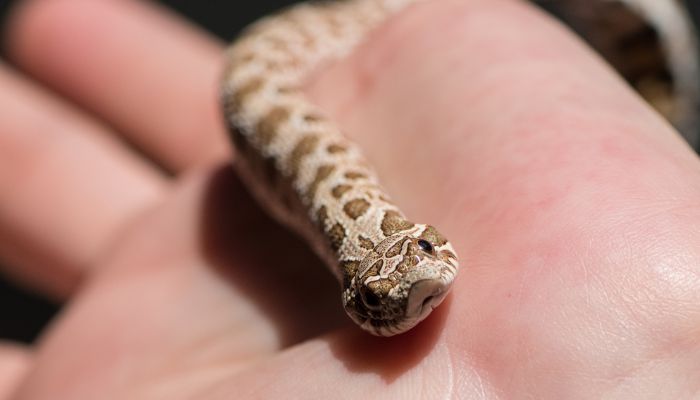
Let’s set the scene. You’re out on a walk with your furry best friend, and suddenly, there’s a hognose snake in your path. What happens next?
Situations where a hognose snake might feel threatened by a dog
Dogs are curious creatures. They love to sniff, poke, and prod at anything that moves. If a dog gets too close to a hognose snake, the snake might feel cornered or threatened.
This could lead to the snake displaying its classic defensive behaviors: hissing, flattening its head, and even playing dead.
The likelihood of a hognose snake attacking a dog
While these snakes can put on quite the show, they’re more bluffers than fighters. They might “strike” with a closed mouth, essentially headbutting the threat.
An actual bite is rare. Remember, these snakes would much rather escape than engage in a confrontation.
How Hognose snake venom affects different dog breeds
If, on the off chance, a hognose snake does bite a dog, the reaction can vary based on the dog’s size and overall health.
Smaller breeds might experience more pronounced symptoms simply due to their size, but it’s still unlikely to be a life-threatening situation. Larger breeds might only show mild discomfort.
In any case, if your dog is bitten, it’s always best to consult with a veterinarian to ensure there aren’t any complications or allergic reactions.
Hognose Snake Behavior and Defense Mechanisms
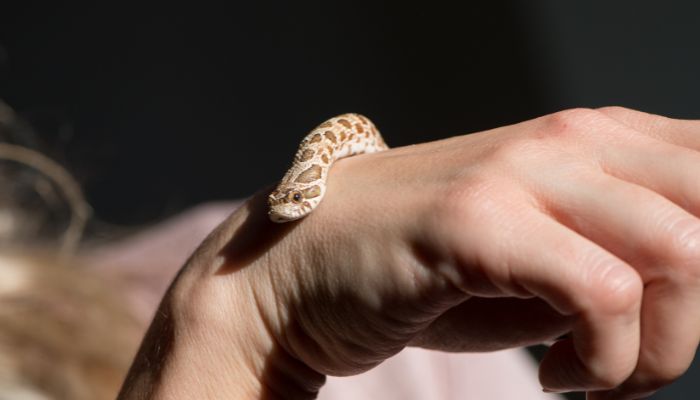
Hognose snakes are quite the actors of the reptile world. Their behavior, especially when threatened, is a mix of drama and deception, designed to deter potential predators without resorting to actual violence.
Let’s dive into their intriguing defense mechanisms.
Their tendency to hiss and flatten their heads
Imagine you’re a small snake, and a potential threat approaches. What do you do? For the hognose snake, the answer is to put on a show.
They’ll often hiss loudly, much like a rattlesnake, and flatten their heads to mimic the appearance of more dangerous snakes, like cobras. This act can be quite convincing, making predators think twice before making a move.
The “bluff” strike with their nose
If the hissing and head-flattening don’t do the trick, the hognose snake has another trick up its sleeve. They might lunge forward in what appears to be a strike. But here’s the catch: they do it with their mouth closed!
It’s more of a headbutt than a bite, a last-ditch effort to scare away the threat without resorting to actual violence.
Why they might feel threatened by larger creatures, including humans
To a hognose snake, larger creatures like humans, dogs, or even bigger birds can be seen as potential predators. Their defense mechanisms are all about survival.
By appearing more dangerous than they actually are, they increase their chances of being left alone.
The Danger to Dogs: What Happens if Bitten?
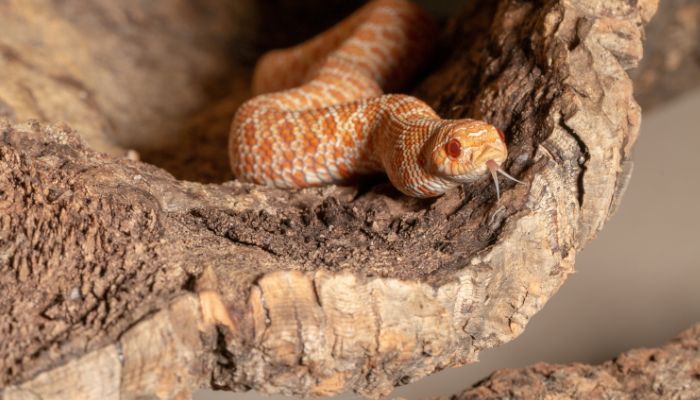
While the hognose snake’s theatrical displays are often enough to deter threats, there’s always a chance of an actual bite, especially if they feel cornered. So, what happens if a dog gets bitten?
Symptoms of a hognose snake bite in dogs
If a dog is bitten by a hognose snake, the symptoms are usually mild. You might notice swelling, redness, or discomfort at the bite site.
Some dogs might lick or paw at the area. In most cases, these symptoms are more due to the physical bite than the venom itself.
The difference between an allergic reaction and venom effects
While the venom of a hognose snake is mild and not typically harmful to dogs, there’s always a chance of an allergic reaction. This can result in more severe swelling, difficulty breathing, and other symptoms.
It’s crucial to differentiate between the two because an allergic reaction requires immediate veterinary attention.
Immediate steps to take if a dog is bitten (First Aid)
If your dog is bitten by a hognose snake, don’t panic. First, keep your dog calm and try to limit their movement. This helps prevent the spread of any venom.
Clean the bite area with mild soap and water, and monitor for any signs of an allergic reaction. Even if the symptoms are mild, it’s always a good idea to consult with a veterinarian to ensure your dog’s health and safety.
Hognose snakes have a range of defense mechanisms to deter threats but they’re not a significant danger to dogs.
However, always exercise caution and be prepared to act if your furry friend has an unexpected encounter with one of these unique reptiles.
The Real Threat: Dogs to Hognose Snakes
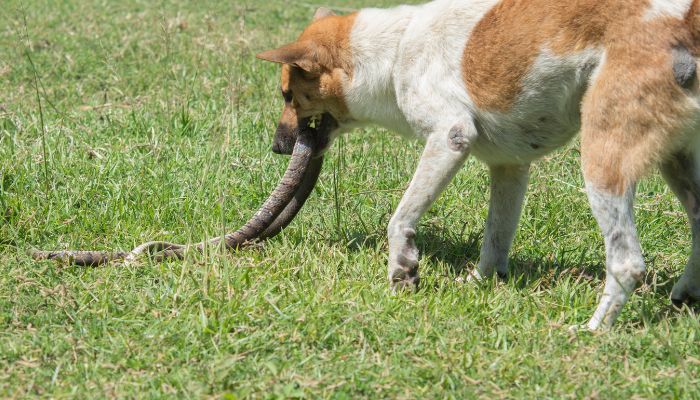
While we often worry about the potential harm snakes might inflict on our pets, we rarely flip the script. But when we do, an interesting perspective emerges. In the dynamic between dogs and hognose snakes, it’s often the snake that’s at greater risk.
How dogs perceive snakes
Dogs, with their insatiable curiosity and keen senses, often perceive snakes as intriguing moving objects. This curiosity can sometimes lead to a playful or even aggressive approach towards the snake.
While some dogs might instinctively stay away, others, especially younger or more curious breeds, might see the snake as a new toy or potential prey.
The danger dogs pose to hognose snakes
For a hognose snake, a dog is a significant threat. Even a playful paw or an investigative sniff can result in injury to the snake.
In confrontations, the snake’s dramatic displays might not deter an excited dog, leading to potential harm or even death for the snake.
Remember, while the hognose might have its theatrical defense mechanisms, it’s still a small, delicate creature up against a much larger mammal.
Preventing Dog and Hognose Snake Interactions
To ensure the safety of both our canine companions and these unique reptiles, it’s essential to minimize their interactions.
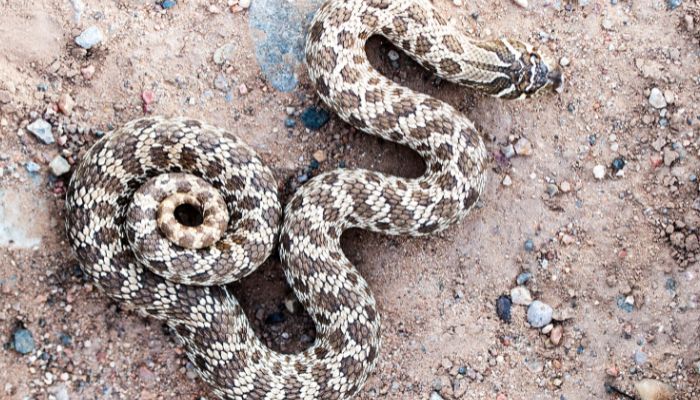
Keeping hognose snakes in secure enclosures
If you’re a reptile enthusiast and have a hognose snake as a pet, ensure it’s kept in a secure enclosure. This not only protects the snake from curious dogs but also provides a safe environment where it can thrive without stress.
Training dogs to avoid snakes
Training plays a crucial role in preventing unwanted interactions. By teaching dogs to stay away from snakes or to respond to commands like “leave it,” you can reduce the chances of a potentially harmful encounter.
There are even specialized snake aversion training programs available in areas where snake encounters are common.
Monitoring outdoor activities
When taking your dog for walks in areas where snakes might be present, always be vigilant. Keep your dog on a leash, stick to well-trodden paths, and avoid tall grass or underbrush where snakes might be hiding.
By being proactive and aware, you can ensure safe outdoor adventures for both you and your dog.
Hognose Snakes as Pets
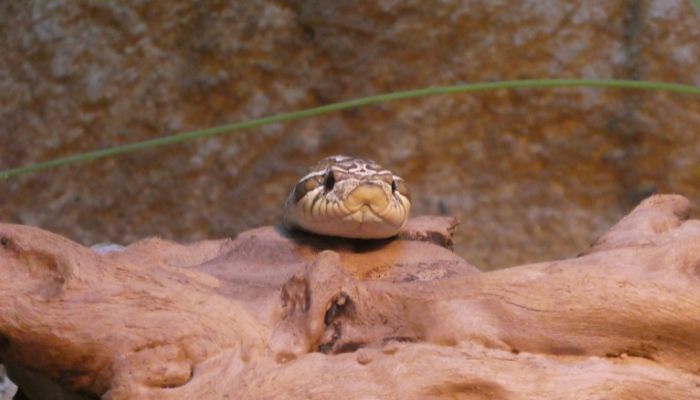
The world of reptile enthusiasts has seen a surge in the popularity of hognose snakes. Their unique appearance, coupled with their captivating defensive displays, has made them a favorite among many.
But before you jump on the hognose bandwagon, there are a few things to consider.
The growing popularity of hognose snakes as pets
Hognose snakes, with their upturned snouts and relatively docile nature, have become increasingly sought after in the pet trade.
Their manageable size, combined with their quirky behaviors, makes them an attractive choice for both novice and experienced reptile keepers.
Plus, there’s no denying that their “bluff” strikes and dramatic “playing dead” acts can be quite the conversation starter!
Considerations for potential hognose snake owners
However, like all pets, hognose snakes come with responsibilities. They require specific habitats, temperatures, and diets (remember their fondness for toads?).
Potential owners should research and prepare adequately to meet these needs. It’s also essential to understand their behavior, especially their defensive displays, so as not to mistake them for aggression or illness.
Ensuring safety for both the snake and other pets in the household
If you have other pets, especially dogs or cats, it’s crucial to ensure the safety of all animals involved. Keep the hognose snake in a secure enclosure to prevent any unwanted interactions.
Educate family members about the snake’s behavior and needs, and consider placing the enclosure in a low-traffic area to reduce stress for the snake.
While hognose snakes can make fascinating and rewarding pets, they’re not a decision to be taken lightly. With proper care, understanding, and safety measures, they can be a delightful addition to a pet-loving household.
Just remember, as with all animals, they deserve respect, care, and love.

Conclusion
You’ve journeyed through the intricate world of hognose snakes and their interactions with dogs.
By now, you understand that while hognose snakes possess venom, it’s primarily tailored for their main prey, toads, and not potent enough to pose a significant threat to larger animals like dogs.
You’ve also discovered the fascinating defense mechanisms of these snakes, from hissing to “bluff” strikes, all designed to deter potential threats.
On the flip side, you’ve seen how our canine companions, with their boundless curiosity, might inadvertently pose risks to these delicate reptiles.
It’s essential to approach both species with respect and knowledge, ensuring safe coexistence. Remember, understanding and awareness are the first steps towards ensuring the safety and well-being of all creatures, whether they slither or walk on four legs.
As you move forward, let this newfound knowledge guide you in fostering harmonious relationships between all pets in your care. Keep learning, stay curious, and always prioritize the well-being of every living being in your environment.
You’re well on your way to becoming a more informed and responsible pet owner and wildlife enthusiast. Keep it up!
FAQ
Navigating the world of hognose snakes can bring up a plethora of questions. Let’s tackle some of the most frequently asked ones to clear the air.
Can Hognose snakes kill humans?
No, hognose snakes cannot kill humans. While they do possess a mild venom, it’s specifically tailored to their primary prey, toads. For humans, a bite might cause some discomfort, but it’s not lethal.
What happens if a Hognose bites you?
If a hognose snake bites you, you might experience mild pain, itching, or swelling at the bite site. The reaction is usually due to the physical bite rather than the venom itself. However, it’s essential to clean the wound and monitor it for any signs of infection or an allergic reaction.
Can hognose venom hurt dogs?
Hognose venom is not potent enough to cause severe harm to dogs. While a bite might result in some swelling or discomfort for the dog, it’s unlikely to be life-threatening. However, always consult with a veterinarian if your dog gets bitten.
What to do if you get bit by a hognose snake?
First, don’t panic. Clean the bite area with mild soap and water. Avoid using ice or tourniquets. Monitor the bite site for any signs of infection or an allergic reaction. If you experience severe swelling, difficulty breathing, or other concerning symptoms, seek medical attention immediately.

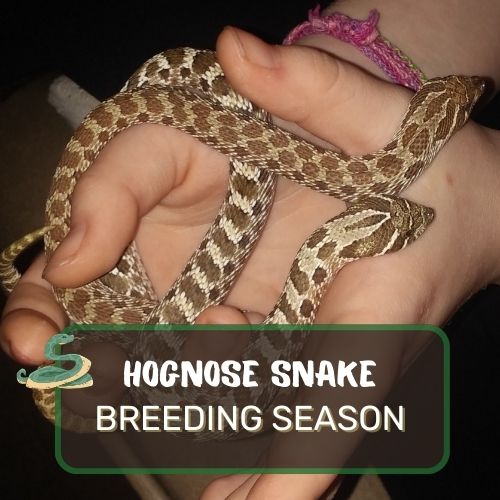
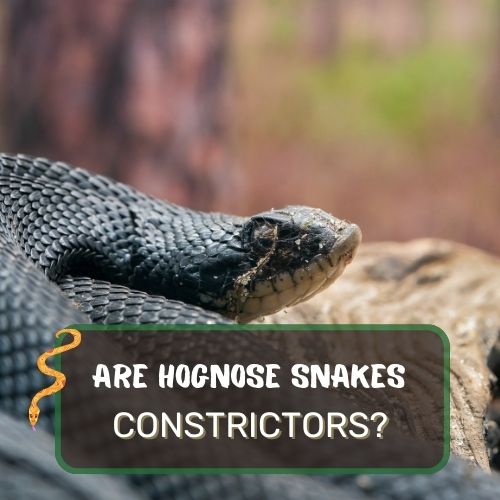
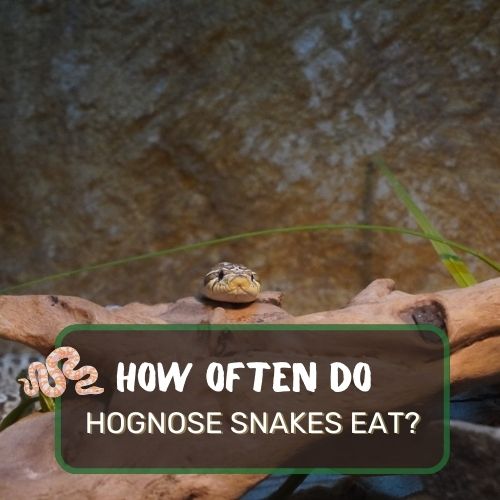
0 Comments